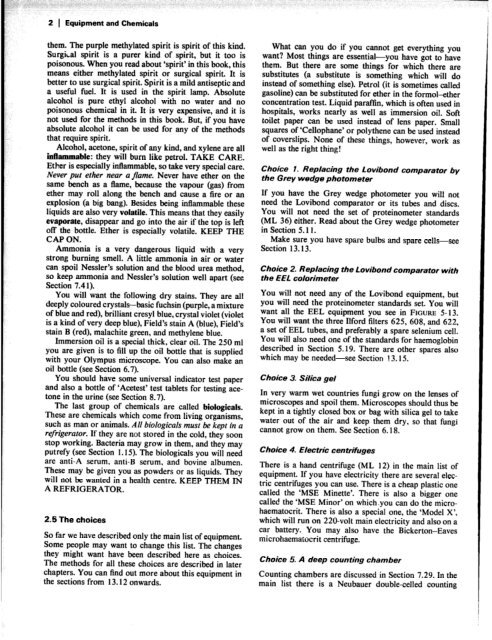MICROFICHE REFERENCE LIBRARY
MICROFICHE REFERENCE LIBRARY
MICROFICHE REFERENCE LIBRARY
You also want an ePaper? Increase the reach of your titles
YUMPU automatically turns print PDFs into web optimized ePapers that Google loves.
2 1 Equipment and Chemicalsthem. The purple methylated spirit is spirit of this kind.Surgical spirit is a purer kind of spirit, but it too ispoisonous. When you read about ‘spirit’ in this book, thismeans either methylated spirit or surgical spirit. It isbetter to use surgical spirit. Spirit is a mild antiseptic anda useful fuel. It is used in the spirit lamp. Absolutealcohol is pure ethyl alcohol with no water and nopoisonous chemical in it. It is very expensive, and it isnot used for the methods in this book. But, if you haveabsolute alcohol it can be used for any of the methodsthat require spirit.Alcohol, acetone, spirit of any kind, and xylene are allinflammable: they will bum like petrol. TAKE CARE.Ether is especially inflammable, so take very special care.Never put ether near a flame. Never have ether on thesame bench as a flame, because the vapour (gas) fromether may roll along the bench and cause a fire or anexplosion (a big bang). Besides being inflammable theseliquids are also very volatile. This means that they easilyevaporate, disappear and go into the air if the top is leftoff the bottle. Ether is especially volatile. KEEP THECAP ON.Ammonia is a very dangerous liquid with a verystrong burning smell. A little ammonia in air or watercan spoil Nessler’s solution and the blood urea method,so keep ammonia and Nessler’s solution well apart (seeSection 7.4 1).You will want the following dry stains. They are alldeeply coloured crystals-basic fuchsin (purple, a mixtureof blue and red), brilliant cresyl blue, crystal violet (violetis a kind of very deep blue), Field’s stain A (blue), Field’sstain B (red), malachite green, and methylene blue.Immersion oil is a special thick, clear oil. The 250 mlyou are given is to fill up the oil bottle that is suppliedwith your Olympus microscope. You can also make anoil bottle (see Section 6.7).You should have some universal indicator test paperand also a bottle of ‘Acetest’ test tablets for testing acetonein the urine (see Section 8.7).The last group of chemicals are called biologicals.These are chemicals which come from living organisms,such as man or animals. All biologicals must be kept in arefrigerator. If they are not stored in the cold, they soonstop working. Bacteria may grow in them, and they mayputrefy (see Section 1.15). The biologicals you will needare anti-A serum, anti-B serum, and bovine albumen.These may be given you as powders or as liquids. Theywill not be wanted in a health centre. KEEP THEM INA REFRIGERATOR.2.5 The choicesSo far we have described only the main list of equipment.Some people may want to change this list. The changesthey might want have been described here as choices.The methods for all these choices are described in laterchapters. You can find out more about this equipment inthe sections from 13.12 onwards.What can you do if you cannot get everything youwant? Most things are essential-you have got to havethem. But there are some things for which there aresubstitutes (a substitute is something which will doinstead of something else). Petrol (it is sometimes calledgasoline) can be substituted for ether in the formol+ztherconcentration test. Liquid paraffin, which is often used inhospitals, works nearly as well as immersion oil. Softtoilet paper can be used instead of lens paper. Smallsquares of ‘Cellophane’ or polythene can be used insteadof coverslips. None of these things, however, work aswell as the right thing!Choice 1. Replacing the Lovibond comparator bythe Grey wedge photometerIf you have the Grey wedge photometer you will notneed the Lovibond comparator or its tubes and discs.You will not need the set of proteinometer standards(ML 36) either. Read about the Grey wedge photometerin Section 5.11.Make sure you have spare bulbs and spare cells-seeSection 13.13.Choice 2. Replacing the Lovibond comparator withthe EEL calorimeterYou will not need any of the Lovibond equipment, butyou will need the proteinometer standards set. You willwant all the EEL equipment you see in FIGURE 5-13.You will want the three Ilford filters 625, 608, and 622,a set of EEL tubes, and preferably a spare selenium cell.You will also need one of the standards for haemoglobindescribed in Section 5.19. There are other spares alsowhich may be needed-see Section ! 3.15.Choice 3. Silica gelIn very warm wet countries fungi grow on the lenses ofmicroscopes and spoil them. Microscopes should thus bekept in a tightly closed box or bag with silica gel to takewater out of the air and keep them dry, so that fungicannot grow on them. See Section 6.18.Choice 4. Electric centrifugesThere is a hand centrifuge (ML 12) in the main list ofequipment. If you have electricity there are several electriccentrifuges you can use. There is a cheap plastic onecalled the ‘MSE Minette’. There is also a bigger onecalled the ‘MSE Minor’ on which.you can do the microhaematocrit.There is also a special one, the ‘Model X’,which will run on 220-volt main electricity and also on acar battery. You may also have the Bickerton-Eavesmicrohaematocrit centrifuge.Choice 5. A deep counting chamberCounting chambers are discussed in Section 7.29. In themain list there is a Neubauer double-celled counting
















